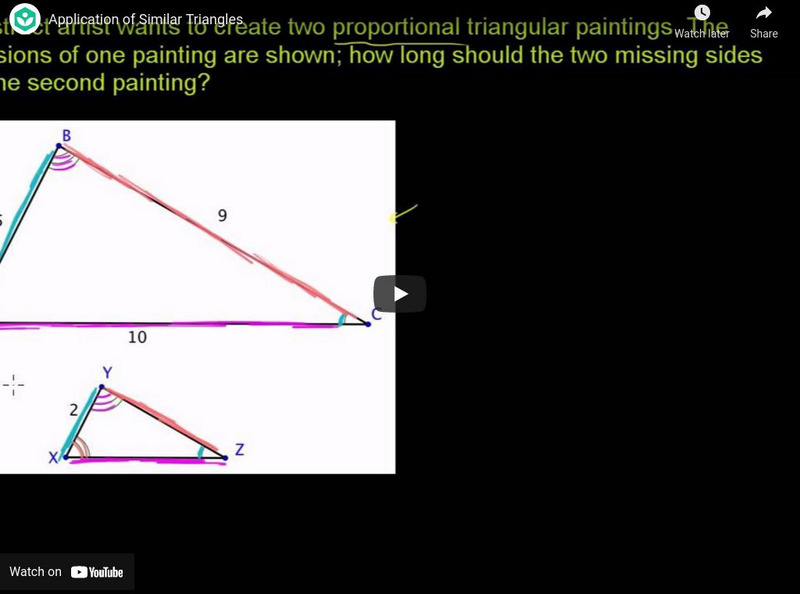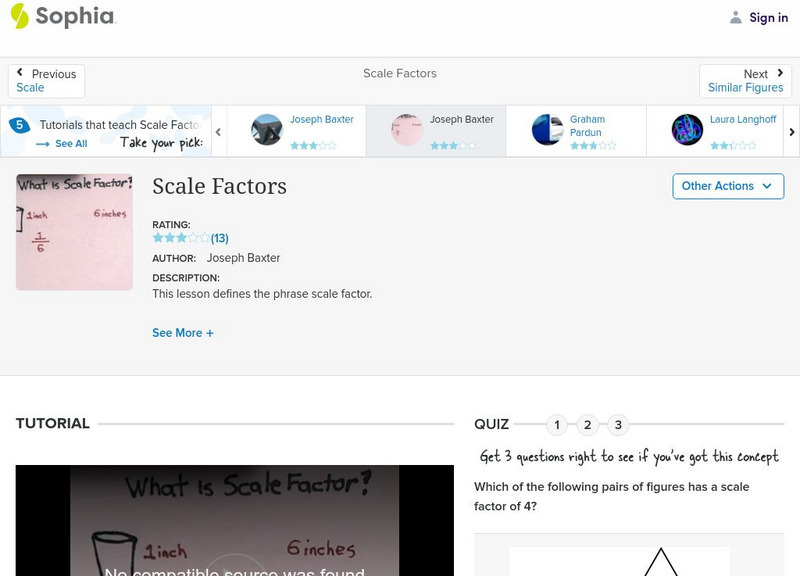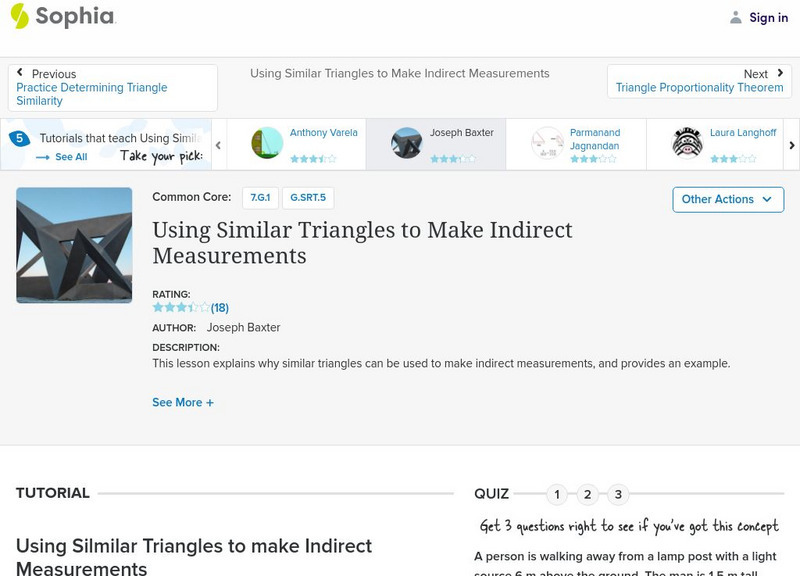Hi, what do you want to do?
CK-12 Foundation
Triangle AA Similarity: Lesson
Two sets of congruent angles leads to three. Using diagrams of two triangles, the presentation intuitively shows that if two sets of angles are congruent, the third set is too. The portion of a geometry playlist uses that information to...
CK-12 Foundation
Inscribed Similar Triangles: Lesson
Create similar triangles with a little altitude. A section of an extensive playlist on basic geometry discusses how an altitude of a right triangle creates similar triangles. Using the theorem, the presentation finds unknown side...
CK-12 Foundation
SAS Similarity Theorem: Lesson
When given two sides and an angle, make similar triangles. The video describes the SAS Similarity Theorem. Using the theorem, the segment of a larger geometry playlist determines whether two triangles are similar.
CK-12 Foundation
Congruent Triangles: Lesson
Given two congruent triangles, the resource provides the definition of congruent triangles and marks the corresponding parts. The portion of a basic geometry playlist shows the triangles are congruent by moving one on top of the other...
TED-Ed
How Many Ways Are There to Prove the Pythagorean Theorem?
There is more than one way to prove the Pythagorean Theorem. Euclid and Einstein found the same way to prove the Pythagorean Theorem. The video introduces several other ways to prove the theorem along with the history of its use.
Mathematics Assessment Project
Modeling Motion: Rolling Cups
Connect the size of a rolling cup to the size of circle it makes. Pupils view videos of cups of different sizes rolling in a circle. Using the videos and additional data, they attempt to determine a relationship between cup...
Curated OER
How Do You Solve a Problem Using Indirect Measurement with Shadows?
Using indirect measurement, this video shows viewers how to find the height of a flagpole. The lecturer employs drawings as well as proportions to solve this problem, explaining each step. A useful resource to aid struggling learners and...
Curated OER
How Do You Solve a Problem Using Indirect Measurement with Shadows?
Using indirect measurement, this video shows viewers how to find the height of a flagpole. The lecturer employs drawings as well as proportions to solve this problem, explaining each step. A useful resource to aid struggling learners and...
Curated OER
How Do You Find Missing Measurements of Similar Figures Using a Scale Factor?
Similar figures have corresponding sides and corresponding angles. With this in mind, missing values can be found by using a scale factor. Not sure how to do that? Watch this video as the instructor illustrates how to set up the known...
Khan Academy
Khan Academy: Geometry: Similar Triangles
Explains how to determine unknown side lengths of similar triangles by identifying corresponding sides and angles ans setting up proportions. The first example is a continuation from the video "Similar Triangles." Practice problems...
Khan Academy
Khan Academy: Geometry: Congruent and Similar Triangles
Explains how to determine if triangles are congruent or similar. [3:53]
Khan Academy
Khan Academy: Applications of Similar Triangles
Explains how to solve a given word problem that involves similar triangles. The problem requires that two unknown side lengths be determined. [5:34]
Khan Academy
Khan Academy: Geometry: Similar Triangles
Explains what it means for two triangles to be similar. Diagram of similar triangles is created with two parallel lines cut by two transversals. [9:34]
Khan Academy
Khan Academy: Geometry: Challenging Similarity Problem
Explains how to determine unknown side lengths in a complex diagram that involves similar triangles. [9:53]
Khan Academy
Khan Academy: Geometry: Ca Geometry: Similar Triangles 1
This video tutorial [12:55] demonstrates solutions to problems #10-14 of California Geometry released state test questions. Problems address understanding of counterexamples, properties of quadrilateral diagonals, and similar triangles.
Khan Academy
Khan Academy: Geometry: Finding Area Using Similarity and Congruence
Explains how to determine the area of a pentagonal shaded region in a triangle. The triangle that is broken into multiple similar and congruent triangles. [10:07]
Khan Academy
Khan Academy: Geometry: Similar Example Problems
Explains how to identify and use similar triangles in order to determine unknown side lengths in two given diagrams. Each diagram also applies knowledge of angles formed when parallel lines are cut by a transversal. [7:37]
Khan Academy
Khan Academy: Geometry: Similarity Example Where Same Side Plays Different Roles
Explains how to determine unknown side lengths in a diagram that involves similar triangles where the two triangles share a side and the shared side corresponds to two different sides in each triangle. [6:05]
Khan Academy
Khan Academy: Geometry: Ca Geometry: More on Congruent and Similar Triangles
Demonstrates solutions to problems #17-20 of California Geometry released state test questions. Problems address understanding of similar triangles, parallelograms and properties of the diagonals of parallelograms. [11:11]
Khan Academy
Khan Academy: Geometry: Similarity Postulates
Explains the minimum amount of information needed to determine if two triangles are similar. Names and illustrates the similarity postulates: AA, SSS, and SAS. [12:14]
Khan Academy
Khan Academy: Similar Triangle Example Problems
Demonstrates how to determine if triangles are similar based on AA, SSS, or SAS similarity postulates. Five different pairs of triangles are compared. [9:23]
Khan Academy
Khan Academy: Geometry: Similar Triangle Basics
Explains the difference between congruent triangles and similar triangles. Introduces the idea of scale factors. [9:17]
Sophia Learning
Sophia: Scale Factors: Lesson 5
This lesson defines the phrase scale factor. It is 5 of 5 in the series titled "Scale Factors."
Sophia Learning
Sophia: Using Similar Triangles to Make Indirect Measurements: Lesson 1
This lesson explains why similar triangles can be used to make indirect measurements, and provides an example. It is 1 of 5 in the series titled "Using Similar Triangles to Make Indirect Measurements."




























